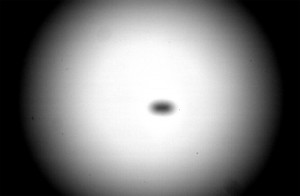From time to time, I see this question to be posted on various discussion boards and forums. As I have recently got a new experience, I show an example of a flat-field calibration frame affected by dew (or possibly icing) formed on the optical window of the CCD camera – see following, highly stretched image:
When does it happen?
- on very humid nights (RH > 92%) when cooling below zero degrees of Celsius
- on not so humid nights (RH > 90%) when using the TEC power on maximum
- when cooling to high difference from ambient temperature
- when the CCD camera has insufficient heating of the front optical window
- when the CCD chamber is not properly sealed
If the CCD chamber is not properly sealed you get icing almost immediately. In case of not sufficient heating of the optical window you see this effect within couple of minutes after you cool the CCD below zero degrees of Celsius. Cooling speed also matters.
The effect of such a problem is noticeable “halo” around brighter stars in a “light” frame caused by dew in the path of the incoming light. Loosing details in an image is another effect. Ultimately you are unable to perform flat field calibration to remove vignetting and dust motes.
Sometimes a heating ring fixes this problem, especially when it is closely coupled to the optical window of the CCD camera (no filters or integrated filter wheel in path). CCD cameras with large detectors (CCD chips) needs effective heating of the front optical window of the CCD chamber to prevent dew forming – effective anti dewing technology ![]() .
.

